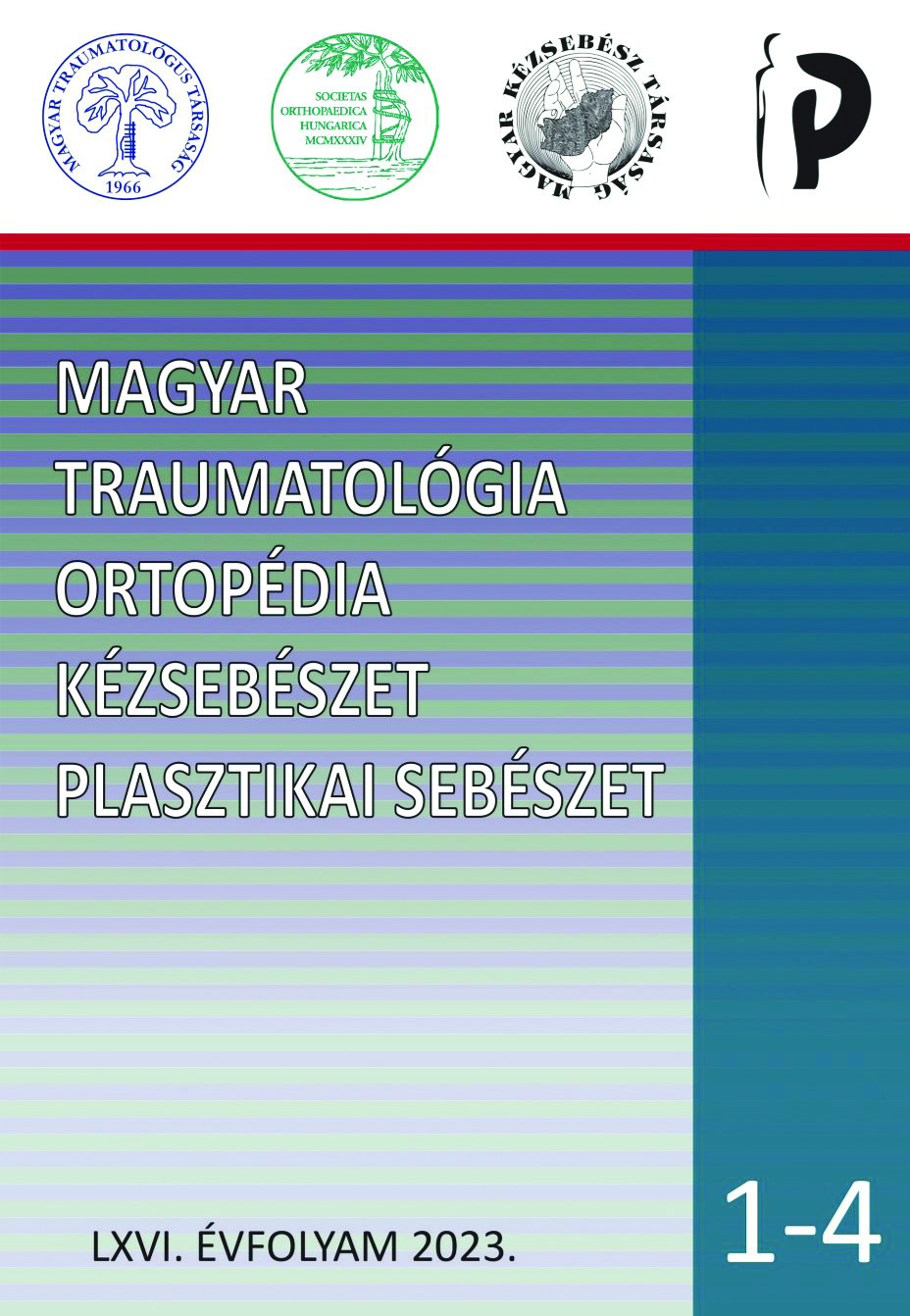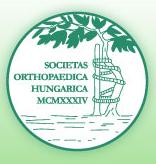„Greater arc injuries” - irodalmi áttekintés egy saját eset bemutatása kapcsán
Absztrakt
A töréssel járó perilunaris ficamok ritka sérülések, azonban a legkörültekintőbb sebészi ellátás és megfelelően vezetett utókezelés mellett is nehéz jó eredményeket elérni. „Greater arc injuries” azon komplex töréssel járó perilunaris ficamok összessége, ahol a szalagsérülés mellett az os lunatum körüli kéztőcsontok, illetve adott esetben a radius törése is bekövetkezik, ezáltal komplexen sérül a csukló biomechanikája. Tekintettel azonban arra, hogy ezek a sérülések a fiatal, munkában és sportban aktív populációt érintik, a kezelés célja a csukló biomechanikájának helyreállítása, úgy, hogy a terhelhetőség és a mozgástartomány visszaszerzése mellett ne maradjanak vissza prearthrotikus elemek. A szerzők közleményükben ismertetik a sérülés etiológiáját, előfordulási gyakoriságát, főbb diagnosztikus (röntgen és CT) jeleit, sebészi ellátását, a rögzítés és utókezelési technikáit, és egy 24 éves férfibeteg esetbemutatása mellett ismertetik – a mindennapi ellátása kapcsán tárgyalják – az ellátási folyamat kérdéses, illetve optimalizálható pontjait.
Hivatkozások
Bain GI, McLean JM, Turner PC, Sood A, Pourgiezis N. Translunate fracture with associated perilunate injury: 3 case reports with introduction of the translunate arc concept. J Hand Surg Am. 2008. 33(10): 1770-1776. https://doi.org/10.1016/j.jhsa.2008.06.017
Berger RA. A method of defining palpable landmarks for the ligament-splitting dorsal wrist capsulotomy. J Hand Surg Am. 2007. 32(8): 1291-1295. https://doi.org/10.1016/j.jhsa.2007.07.023
Forli A, Courvoisier A, Wimsey S, Corcella D, Moutet F. Perilunate dislocations and transscaphoid perilunate fracture-dislocations: a retrospective study with minimum ten-year follow-up. J Hand Surg Am. 2010. 35(1): 62-68. https://doi.org/10.1016/j.jhsa.2009.09.003
Garcia–Elias M., Lunch AL. Wrist instabilities, misalignments, and dislocations. In: Scott W. Wolfe, William C. Pederson, Scott H. Kozin, Mark S. Cohen. Green's operative hand surgery. 7th Ed. Philadelphia, Elsevier, 2017. 418-478. p.
Herzberg G, Comtet JJ, Linscheid RL, Amadio PC, Cooney WP, Stalder J. Perilunate dislocations and fracture-dislocations: a multicenter study. J Hand Surg Am. 1993. 18(5): 768-779. https://doi.org/10.1016/0363-5023(93)90041-Z
Johnson RP. The acutely injured wrist and its residuals. Clin Orthop Relat Res. 1980. (149): 33-44. https://doi.org/10.1097/00003086-198006000-00005
Kardashian G, Christoforou DC, Lee SK. Perilunate dislocations. Bull NYU Hosp Jt Dis. 2011. 69(1): 87-96.
Knoll VD, Allan C, Trumble TE. Trans-scaphoid perilunate fracture dislocations: results of screw fixation of the scaphoid and lunotriquetral repair with a dorsal approach. J Hand Surg Am. 2005. 30(6): 1145-1152. Erratum in: J Hand Surg Am. 2006. 31(2): 328. https://doi.org/10.1016/j.jhsa.2005.07.007
Komurcu M, Kürklü M, Ozturan KE, Mahirogullari M, Basbozkurt M. Early and delayed treatment of dorsal transscaphoid perilunate fracture-dislocations. J Orthop Trauma. 2008. 22(8): 535-540. https://doi.org/10.1097/BOT.0b013e318183eb23
Kremer T, Riedel K., Perilunate dislocations. In: Garcia-Elias M., Mathoulin C.: Articular injury of the wrist. FESSH 2014 Instructional Course Book. New York. Thieme. 2014. 53-60. p
Kremer T, Wendt M, Riedel K, Sauerbier M, Germann G, Bickert B. Open reduction for perilunate injuries. Clinical outcome and patient satisfaction. J Hand Surg Am. 2010. 35(10): 1599-1606. https://doi.org/10.1016/j.jhsa.2010.06.021
Mayfield JK, Johnson RP, Kilcoyne RK. Carpal dislocations: pathomechanics and progressive perilunar instability. J Hand Surg Am. 1980. 5(3): 226-241. https://doi.org/10.1016/S0363-5023(80)80007-4
Ramponi DR, Good AE. Perilunate and lunate dislocations. Adv Emerg Nurs J. 2023. 45(2): 119-122. https://doi.org/10.1097/TME.0000000000000453
Sandoval E, Cecilia D, Garcia-Paredero E. Surgical treatment of trans-scaphoid, transcapitate, transtriquetral, perilunate fracture-dislocation with open reduction, internal fixation and lunotriquetral ligament repair. J Hand Surg Eur. 2008. 33(3): 377-379. https://doi.org/10.1177/1753193408089531
Scalcione LR, Gimber LH, Ho AM, Johnston SS, Sheppard JE, Taljanovic MS. Spectrum of carpal dislocations and fracture-dislocations: Imaging and management. Am J Roentgenol. 2014. 203(3): 541-550. https://doi.org/10.2214/AJR.13.11680
Severo AL, Lemos MB, Pereira TAP, Fajardo RDP, Maia PEC, Lech O. Trans-scaphoid perilunate fracture dislocation beyond Mayfield stage IV: a case report on a new classification proposal. Rev Bras Ortop. 2017. 53(5): 643-646. https://doi.org/10.1016/j.rboe.2017.05.008
Shivanna D, Manjunath D, Amaravathi R. Greater arch injuries. J Hand Microsurg. 2014. 6(2): 69-73. https://doi.org/10.1007/s12593-014-0143-5
van der Oest MJW, Duraku LS, Artan M, Hundepool CA, Power DM, Rajaratnam V, Zuidam JM. Perilunate injury timing and treatment options: A systematic review. J Wrist Surg. 2021. 11(2): 164-176. https://doi.org/10.1055/s-0041-1735841
Zolczer L, Nemes J, Glanz J. A kéztőízület instabilitása (funkcionális anatómia, instabilitási formák, diagnosztika) [Instability of the wrist joint (functional anatomy, forms of instability, diagnosis)]. Hungarian. Magy. Traumatol. Orthop. Helyreallito Seb. 1988. 31. (4): 267-276.











